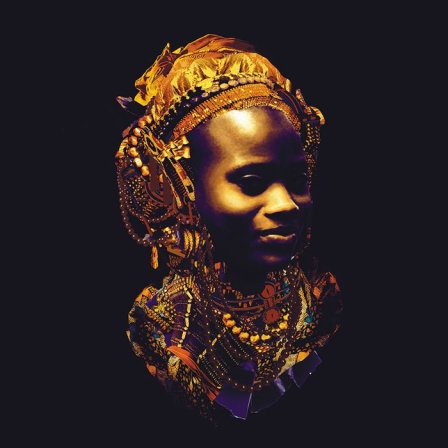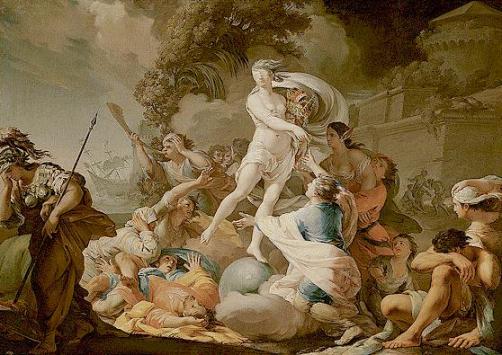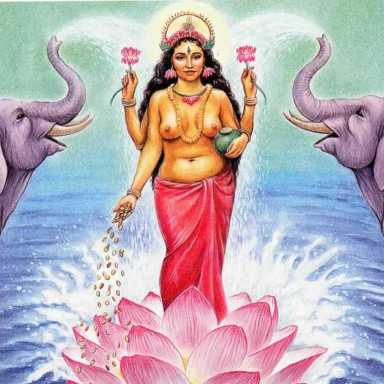 “Hathor ‘s themes are joy, love, femininity, beauty, sexuality and the sky. Her symbols are mirrors, cows, sandalwood and rose incense and rattles. One of the most beloved sky Goddesses in Egypt, Hathor brings happiness, romance and an appreciation for musical arts into our lives. Sacred or erotic dances are a welcome offering for Hathor, as is any effort to beautify the body. As the patroness of the toilette, She also protects women and embodies the pinnacle of feminine qualities. Her favorite musical instrument, the sistrum (a kind of rattle), was said to banish evil wherever it was played.
“Hathor ‘s themes are joy, love, femininity, beauty, sexuality and the sky. Her symbols are mirrors, cows, sandalwood and rose incense and rattles. One of the most beloved sky Goddesses in Egypt, Hathor brings happiness, romance and an appreciation for musical arts into our lives. Sacred or erotic dances are a welcome offering for Hathor, as is any effort to beautify the body. As the patroness of the toilette, She also protects women and embodies the pinnacle of feminine qualities. Her favorite musical instrument, the sistrum (a kind of rattle), was said to banish evil wherever it was played.
[Known as the Month of Hathor] from September 17 until October 16, Hathor reigned in Egypt. To honor this Goddess, make an effort to make yourself as physically appealing as possible, then spend some time with a significant other or in a social setting. In the first case, Hathor’s favor will increase love and passion; in the second, She’ll improve your chances of finding a bed partner.
To fill your living space with Hathor’s energy, take rice or beans and put them in a plastic container (this creates a makeshift rattle). Play some lusty music and dance clockwise around every room of the home shaking the rattle. Perhaps add a verbal charm like this one:
‘Love, passion and bliss
By Hathor’s power kissed!’
This drives away negativity, generates joyful vibrations, promotes artistic awareness, and increases love each time you kiss someone in your home.”
(Patricia Telesco, “365 Goddess: a daily guide to the magic and inspiration of the goddess”.)

“One of the world’s greatest Goddesses, Hathor was worshiped for more than a millennium longer than the life, to date, of Christianity. For more than 3,000 years Her joyful religion held sway over Egypt.
Small wonder, then, that a profusion of legends surrounded Her, or that She was depicted in so many different guises: at once mother and daughter of the sun, both a lioness and a cow, sometimes a woman, and sometimes a tree. Goddess of the underworld, She was also ruler of the sky. Patron of foreigners, She was mother of the Egyptians. Like Ishtar to the east, She was a complex embodiment of feminine possibilities.

“Hathor” by Hrana Janto
One of Hathor’s most familiar forms was the winged cow of creation who gavebirth to the universe. Because She bore them, She owned the bodies of the dead; thus She was queen of the underworld. Again, She appeared as the seven (or nine) Hathors who materialized at a child’s birth and foretold its inescapable destiny. Then too, She was the special guardian spirit of all women and all female animals.
‘Habitation of the hawk and birdcage of the soul,’ Hathor was essentially the body in which the soul resides. As such, She was patron of bodily pleasures: the pleasures of sound, in music and song; the joys of the eye, in art, cosmetics, the weaving of garlands; the delight of motion in dance and in love; and all the pleasures of touch. In Her temples, priestesses danced and played their tinkling tambourines, probably enjoying other sensual pleasures with the worshipers as well. (Not without cause did the Greeks compare Her to Aphrodite.)
Her festivals were carnivals of intoxication, especially that held at Dendera on New Year’s Day, when Hathor’s image was brought forth from Her temple to catch the rays of the newborn sun, whereupon revels broke out and throbbed through the streets. (In this capacity She was called Tanetu.) She was a most beloved Goddess to Her people, and they held fast to Her pleasureful rites long into historical times” (p. 145 -146).
J. Hill tells us that “She was known as ‘the Great One of Many Names’ and Her titles and attributes are so numerous that She was important in every area of the life and death of the ancient Egyptians. It is thought that Her worship was widespread even in the Predynastic period because She appears on the Narmer palette. However, some scholars suggest that the cow-headed Goddess depicted on the palette is in fact Bat (an ancient cow Goddess who was largely absorbed by Hathor) or even Narmer himself. However, She was certainly popular by the Old Kingdom as She appears with Bast in the valley temple of Khafre at Giza. Hathor represents Upper Egypt and Bast represents Lower Egypt.

She was originally a personification of the Milky Way, which was considered to be the milk that flowed from the udders of a heavenly cow (linking her with Nut, Bat and Mehet-Weret). As time passed She absorbed the attributes of many other Goddesses but also became more closely associated with Isis, who to some degree usurped Her position as the most popular and powerful Goddess. Yet She remained popular throughout Egyptian history. More festivals were dedicated to Her and more children were named after Her than any other god or goddess of Ancient Egypt. Her worship was not confined to Egypt and Nubia. She was worshipped throughout Semitic West Asia, Ethiopian, Somlia and Libya, but was particularly venerated in the city of Byblos.
She was a sky Goddess, known as ‘Lady of Stars’ and ‘Sovereign of Stars’ and linked to Sirius (and so the Goddesses Sopdet and Isis). Her birthday was celebrated on the day that Sirius first rose in the sky (heralding the coming innundation). By the Ptolemaic period, She was known as the Goddess of Hethara, the third month of the Egyptian calendar.
As ‘the Mistress of Heaven’ She was associated with Nut, Mut and the Queen. While as ‘the Celestial Nurse’ She nursed the Pharaoh in the guise of a cow or as a sycamore fig (because it exudes a white milky substance). As ‘the Mother of Mothers’ She was the Goddess of women, fertility, children and childbirth. She had power over anything having to do with women from problems with conception or childbirth, to health and beauty and matters of the heart. However, She was not exclusively worshipped by women and unlike the other gods and Goddesses She had both male and female priests.
 Hathor was also the Goddess of beauty and patron of the cosmetic arts. Her traditional votive offering was two mirrors and She was often depicted on mirrors and cosmetic palettes. Yet She was not considered to be vain or shallow, rather She was assured of Her own beauty and goodness and loved beautiful and good things. She was known as ‘the mistress of life’ and was seen as the embodiment of joy, love, romance, perfume, dance, music and alcohol. Hathor was especially connected with the fragrance of myrrh incense, which was considered to be very precious and to embody all of the finer qualities of the female sex. Hathor was associated with turquoise, malachite, gold and copper. As ‘the Mistress of Turquoise’ and the ‘lady of Malachite’ She was the patron of miners and the Goddess of the Sinai Peninsula (the location of the famous mines). The Egyptians used eye makeup made from ground malachite which had a protective function (in fighting eye infections) which was attributed to Hathor.
Hathor was also the Goddess of beauty and patron of the cosmetic arts. Her traditional votive offering was two mirrors and She was often depicted on mirrors and cosmetic palettes. Yet She was not considered to be vain or shallow, rather She was assured of Her own beauty and goodness and loved beautiful and good things. She was known as ‘the mistress of life’ and was seen as the embodiment of joy, love, romance, perfume, dance, music and alcohol. Hathor was especially connected with the fragrance of myrrh incense, which was considered to be very precious and to embody all of the finer qualities of the female sex. Hathor was associated with turquoise, malachite, gold and copper. As ‘the Mistress of Turquoise’ and the ‘lady of Malachite’ She was the patron of miners and the Goddess of the Sinai Peninsula (the location of the famous mines). The Egyptians used eye makeup made from ground malachite which had a protective function (in fighting eye infections) which was attributed to Hathor.
 She was the patron of dancers and was associated with percussive music, particularly the sistrum (which was also a fertility fetish). She was also associated with the Menit necklace (which may also have been a percussion instrument) and was often known as ‘the Great Menit’. Many of Her priests were artisans, musicians, and dancers who added to the quality of life of the Egyptians and worshipped Her by expressing their artistic natures. Hathor was the incarnation of dance and sexuality and was given the epithet ‘Hand of God’ (refering to the act of masturbation) and ‘Lady of the Vulva’. One myth tells that Ra had become so despondent that he refused to speak to anyone. Hathor (who never suffered depression or doubt) danced before him exposing Her private parts, which caused him to laugh out loud and return to good spirits.
She was the patron of dancers and was associated with percussive music, particularly the sistrum (which was also a fertility fetish). She was also associated with the Menit necklace (which may also have been a percussion instrument) and was often known as ‘the Great Menit’. Many of Her priests were artisans, musicians, and dancers who added to the quality of life of the Egyptians and worshipped Her by expressing their artistic natures. Hathor was the incarnation of dance and sexuality and was given the epithet ‘Hand of God’ (refering to the act of masturbation) and ‘Lady of the Vulva’. One myth tells that Ra had become so despondent that he refused to speak to anyone. Hathor (who never suffered depression or doubt) danced before him exposing Her private parts, which caused him to laugh out loud and return to good spirits.

As the ‘lady of the west’ and the ‘lady of the southern sycamore’ She protected and assisted the dead on their final journey. Trees were not commonplace in ancient Egypt, and their shade was welcomed by the living and the dead alike. She was sometimes depicted as handing out water to the deceased from a sycamore tree (a role formerly associated with Amentet who was often described as the daughter of Hathor) and according to myth, She (or Isis) used the milk from the Sycamore tree to restore sight to Horus who had been blinded by Set. Because of Her role in helping the dead, She often appears on sarcophagi with Nut (the former on top of the lid, the later under the lid). She occassionally took the form of the ‘Seven Hathors’ who were associated with fate and fortune telling. It was thought that the ‘Seven Hathors’ knew the length of every childs life from the day it was born and questioned the dead souls as they travelled to the land of the dead. Her priests could read the fortune of a newborn child, and act as oracles to explain the dreams of the people. People would travel for miles to beseech the Goddess for protection, assistance and inspiration. The ‘Seven Hathors’ were worshiped in seven cities: Waset (Thebes), Iunu (On, Heliopolis), Aphroditopolis, Sinai, Momemphis, Herakleopolis, and Keset. They may have been linked to the constellations Pleiades.

However, She was also a Goddess of destruction in Her role as the Eye of Ra – defender of the sun god. According to legend, people started to criticise Ra when he ruled as Pharaoh. Ra decided to send his ‘eye’ against them (in the form of Sekhmet). She began to slaughter people by the hundred. When Ra relented and asked Her to stop She refused as She was in a blood lust. The only way to stop the slaughter was to colour beer red (to resemble blood) and pour the mixture over the killing fields. When She drank the beer, She became drunk and drowsy, and slept for three days. When She awoke with a hangover She had no taste for human flesh and mankind was saved. Ra renamed Her Hathor and She became a Goddess of love and happiness. As a result, soldiers also prayed to Hathor/Sekhmet to give them Her strength and focus in battle.

“O Gold, Hathor” by ~MysticalMike
Her husband Horus the elder was associated with the pharaoh, so Hathor was associated with the Queen. Her name is translated as ‘The House of Horus’, which refers both to the sky (where Horus lived as a Hawk) and to the royal family. She had a son named Ihy (who was a god of music and dancing) with Horus-Behdety and the three were worshipped at Denderah (Iunet). However, Her family relationships became increasingly confusing as time passed. She was probably first considered to be the wife of Horus the elder and the daughter of Ra, but when Ra and Horus were linked as the composite deity Re-Horakty She became both the wife and the daughter of Ra.
This strengthened Her association with Isis, who was the mother of Horus the child by Osiris. In Hermopolis (Khmunu) Thoth was the foremost god, and Hathor was considered to be his wife and the mother of Re-Horakhty (a composite deity which merged Ra with Hor-akhty).
Of course, Thoth already had a wife, Seshat (the Goddess of reading, writing, architecture and arithmetic), so Hathor absorbed Her role including acting as a witness at the judgement of the dead. Her role in welcoming the dead gained Her a further husband – Nehebkau (the guardian of the entrance of the underworld). Then when Ra and Amun merged, Hathor became seen as the wife of Sobek who was considered to be an aspect of Amen-Ra. Yet Sobek was also associated with Seth, the enemy of Horus!

“Hathor” by Deborah Bell
She took the form of a woman, goose, cat, lion, malachite, sycamore fig, to name but a few. However, Hathor’s most famous manifestation is as a cow and even when She appears as a woman She has either the ears of a cow, or a pair of elegant horns. When She is depicted as entirely a cow, She always has beautifully painted eyes. She was often depicted in red (the color of passion) though Her sacred color is turquoise. It is also interesting to note that only She and the dwarf god Bes (who also had a role in childbirth) were ever depicted in portrait (rather than in profile). Isis borrowed many of Her functions and adapted Her iconography to the extent that it is often difficult to be sure which of the two Goddesses is depicted. However, the two deities were not the same. Isis was in many ways a more complex deity who suffered the death of Her husband and had to fight to protect Her infant son, so She understood the trials and tribulations of the people and could relate to them. Hathor, on the other hand, was the embodiment of power and success and did not experience doubts. While Isis was merciful, Hathor was single minded in pursuit of Her goals. When She took the form of Sekhmet, She did not take pity on the people and even refused to stop killing when ordered to do so.” [1]
Sources:
Hill, J. Ancientegyptonline.co.uk, “Hathor“.
Monaghan, Patricia. The New Book of Goddesses and Heroines, “Hathor”.
Suggested Links:
Altunay, Erhan. Thewisemag.com, “Hathor and Isis: The Great Goddesses of Ancient Egypt“.
Barkemeijer de Wit, Rhiannon. Pyramidcompany.com, “Who Is Goddess Hathor…“.
Goddess-guide.com, “Hathor the Egyptian Goddess“.
Houser, Kelly. Order of the White Moon, “Hathor, Queen of Heaven“.
Journal of a Poet, “Hathor“.
Mydailygoddess.blogspot.com, “Hathor: Pleasure“.
Revel, Anita. igoddess.com, “Hathor: shape-shift & shine“.
Seawright, Caroline. Thekeep.org, “Hathor, Goddess of Love, Music and Beauty…“.
Starlight. Goddessschool.com, “Hathor“.
Took, Thalia. A-Muse-ing Grace Gallery, “Hathor“.
Thewhitegoddess.co.uk, “Hathor – Eye of Ra“.
Wikipedia, “Hathor“.

















































